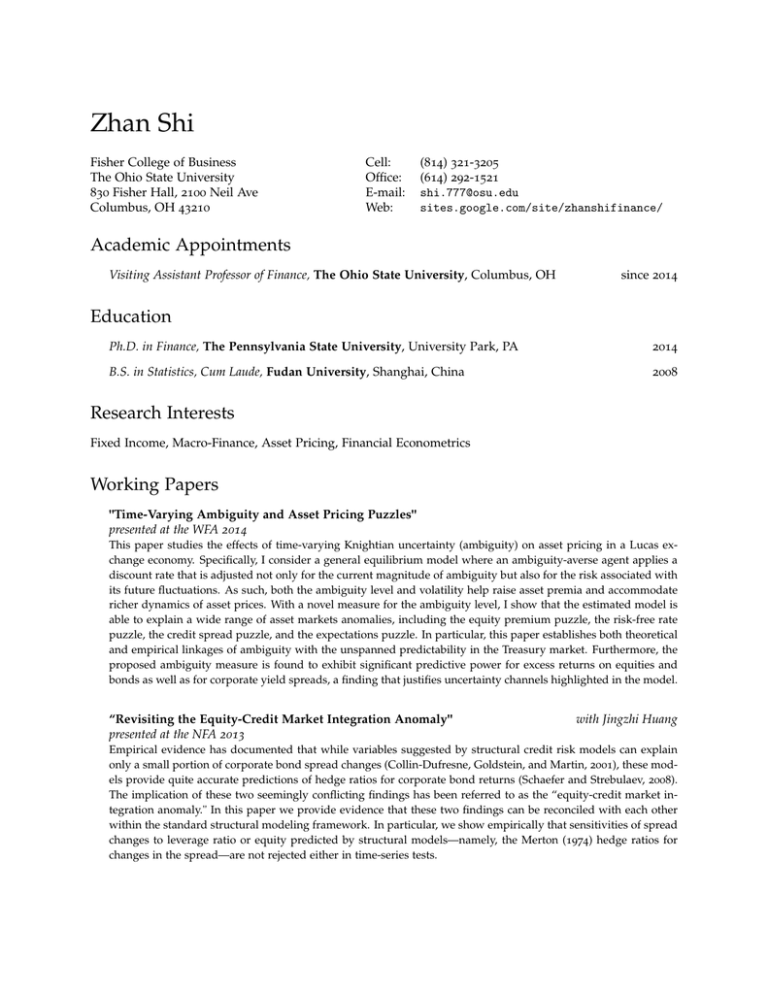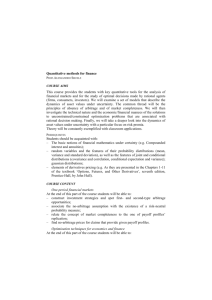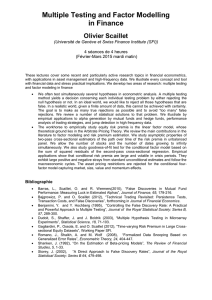Zhan Shi
advertisement

Zhan Shi Fisher College of Business The Ohio State University 830 Fisher Hall, 2100 Neil Ave Columbus, OH 43210 Cell: Office: E-mail: Web: (814) 321-3205 (614) 292-1521 shi.777@osu.edu sites.google.com/site/zhanshifinance/ Academic Appointments Visiting Assistant Professor of Finance, The Ohio State University, Columbus, OH since 2014 Education Ph.D. in Finance, The Pennsylvania State University, University Park, PA 2014 B.S. in Statistics, Cum Laude, Fudan University, Shanghai, China 2008 Research Interests Fixed Income, Macro-Finance, Asset Pricing, Financial Econometrics Working Papers "Time-Varying Ambiguity and Asset Pricing Puzzles" presented at the WFA 2014 This paper studies the effects of time-varying Knightian uncertainty (ambiguity) on asset pricing in a Lucas exchange economy. Specifically, I consider a general equilibrium model where an ambiguity-averse agent applies a discount rate that is adjusted not only for the current magnitude of ambiguity but also for the risk associated with its future fluctuations. As such, both the ambiguity level and volatility help raise asset premia and accommodate richer dynamics of asset prices. With a novel measure for the ambiguity level, I show that the estimated model is able to explain a wide range of asset markets anomalies, including the equity premium puzzle, the risk-free rate puzzle, the credit spread puzzle, and the expectations puzzle. In particular, this paper establishes both theoretical and empirical linkages of ambiguity with the unspanned predictability in the Treasury market. Furthermore, the proposed ambiguity measure is found to exhibit significant predictive power for excess returns on equities and bonds as well as for corporate yield spreads, a finding that justifies uncertainty channels highlighted in the model. “Revisiting the Equity-Credit Market Integration Anomaly" presented at the NFA 2013 with Jingzhi Huang Empirical evidence has documented that while variables suggested by structural credit risk models can explain only a small portion of corporate bond spread changes (Collin-Dufresne, Goldstein, and Martin, 2001), these models provide quite accurate predictions of hedge ratios for corporate bond returns (Schaefer and Strebulaev, 2008). The implication of these two seemingly conflicting findings has been referred to as the “equity-credit market integration anomaly." In this paper we provide evidence that these two findings can be reconciled with each other within the standard structural modeling framework. In particular, we show empirically that sensitivities of spread changes to leverage ratio or equity predicted by structural models—namely, the Merton (1974) hedge ratios for changes in the spread—are not rejected either in time-series tests. Zhan Shi “Understanding Term Premia on Real Bonds" presented at the SICF 2012, NFA 2012, AFA 2013 2 with Jingzhi Huang Real bonds are a very important asset class and deciphering their risk-return relationship deepens our already extensive understanding about term premia. However, there has been little research on the dynamic behavior and economic determinants of risk premia on such bonds. This paper takes a series of steps towards extending extant evidence on nominal bond premia to their real counterparts. First, we document empirically that the real bond risk premium changes over time and fluctuates between positive and negative values. Second, we find that the real term structure itself contains a component that, albeit undetectable from cross section of bond yields, drives risk premia. Finally, we examine the potential link between the real bond premia and macroeconomic variables. We find that macro factors associated with real estate and consumer income and expenditure can capture a large portion of forecastable variations in excess returns on real bonds. Our empirical results indicate an essential need to propose asset pricing models such that implied real yields are able to account for these stylized facts. “Estimation of Asset Value and Asset Volatility in Structural Models" with Jingzhi Huang and Yuchen Luo One widely used approach to credit risk modeling is the structural framework of Black and Scholes (1973) and Merton (1974). The implementation of a structural credit risk model requires the knowledge of two important and yet unobservable parameters, asset value and asset volatility. Various methods have been proposed in the literature for the estimation of these two parameters; however, so far there is no consensus on what method should be used in practice. We conduct a comprehensive comparison utilizing rigorous mathematical derivation and simulation. We make recommendations on which method to use. We also shed new light on the previous critics on some of the methods. We propose a methodology for analyzing the source of estimation errors, which could be applied in a much more general setting. "Determinants of Bond Risk Premia" presented at the AFA 2011, under review with Jingzhi Huang In this paper, we provide new and robust evidence on the power of macro variables for forecasting bond risk premia by using a recently developed model selection method–the supervised adaptive group “least absolute shrinkage and selection operator" (lasso) approach. We identify a single macro factor that can not only subsume the macro factors documented in the existing literature but also can substantially raise their forecasting power for future bond excess returns. Specifically, we find that the new macro factor, a linear combination of four group factors (including employment, housing, and price indices), can explain the variation in excess returns on bonds with maturities ranging from 2 to 5 years up to 43%. The new factor is countercyclical and furthermore picks up unspanned predictability in bond excess returns. Namely, the new macro factor contains substantial information on expected excess returns (as well as expected future short rates) but has negligible impact on the cross section of bond yields. Book Chapter Model Selection for High-Dimensional Problems (with Jingzhi Huang and Wei Zhong), 2013, Handbook of Financial Econometrics and Statistics, edited by C.F. Lee and John Lee, Chapter 77, Springer Verlag. Professional Activities Presentations Time-Varying Ambiguity and Asset Pricing Puzzles Zhan Shi 2014 Western Finance Association Meeting, Monterey 2013 Financial Management Association Doctoral Student Consortium Revisiting the Equity-Credit Market Integration Anomaly 2014 Fixed Income Conference, Charleston 2013 Asian Finance Association Meeting, Nanchang* 2013 ITAM Finance Conference, Mexico City* 2013 Northern Finance Association Meeting, Quebec City* 2013 Annual Derivatives Securities and Risk Management Conference* Understanding Term Premia on Real Bonds 2013 Fixed Income Conference, Charleston 2013 American Finance Association Meeting, San Diego 2012 Northern Finance Association Meeting, Niagara Falls 2012 Singapore International Conference on Finance 2012 Midwest Finance Association Meeting, New Orleans Estimation of Asset Value and Asset Volatility in Structural Models 2014 Midwest Finance Association Meeting, Orlando Determinants of Bond Risk Premia 2012 Fixed Income Conference, Charleston* 2011 American Finance Association Meeting, Denver 2010 Financial Management Association Meeting, New York 2010 SAIF and CKGSB Summer Research Conference, Shanghai 2010 China International Conference in Finance 2010 Annual Derivatives Securities and Risk Management Conference * presented by a co-author Discussions 2014 Midwest Finance Association Meeting, Orlando 2013 Midwest Finance Association Meeting, Chicago 2012 Fixed Income Conference, Charleston 2012 Midwest Finance Association Meeting, New Orleans 2010 Financial Management Association Meeting, New York Program Committee 2014 Midwest Finance Association Meeting, Orlando 2013 Midwest Finance Association Meeting, Chicago 3 Zhan Shi 4 Teaching Finance 410: Derivative Markets (undergraduate) Instructor Summer 2010: No instructor report generated due to limited number of students Summer 2011: Student evaluations—6.3/7.0 Finance 406: Security Analysis and Portfolio Management (undergraduate) Instructor Summer 2012: Student evaluations—5.9/7.0 Fall 2012: Special section intended for non-finance majors Finance 406: Security Analysis and Portfolio Management (undergraduate) Teaching Assistant Fall 2011 Awards and Grants WFA Cubist Systematic Strategies Ph.D. Candidate Award MFA Doctoral Student Travel Grant 2014 2013, 2014 Kenneth J. Carey Memorial Scholarship 2012 Competitive Dissertation Summer Award 2012 Smeal Research Grant Award 2009-2013 Fudan Best Undergraduate Thesis Prize Last updated: September 2, 2014 https://sites.google.com/site/zhanshifinance/ 2008




